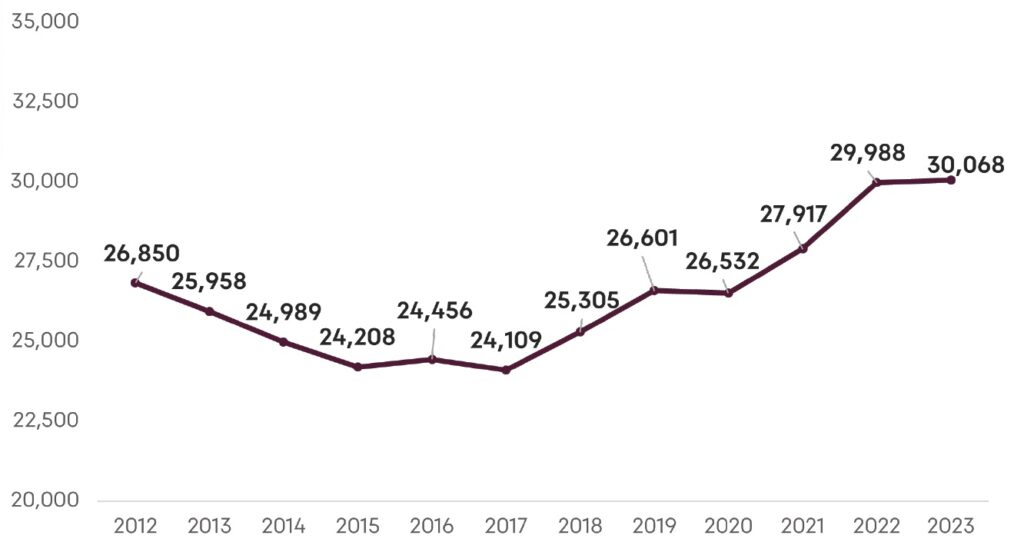NAAB REPORT ON ARCHITECTURE EDUCATION
Recently NAAB (National Architectural Accrediting Board) released its annual reports on Architecture Education.
As shared on the NAAB website: “This report, to be produced annually, shares the accreditation decisions made by the NAAB in the previous year, provides a review of the aggregated statistics provided by each accredited program, and reports on other activities.”
2023 NAAB Annual Report on Architecture Education (PDF)
https://www.naab.org/accreditation/publications/
2023 NAAB Report on Architecture Education at Minority-Serving Institutions (PDF)
https://www.naab.org/accreditation/publications/
For this week’s essay, we will focus on the first of the two reports and more specifically, the aggregated statistics of the accredited programs. Below are more details on accredited programs, enrollment, and degrees awarded.
Note: Definitions used in these NAAB reports are based on the glossary of terms used. Integrated Postsecondary Education Data System (IPEDS). IPEDS is the “core postsecondary data collection program” for the National Center for Education Statistics. Data are collected from all primary providers of postsecondary education in the United States in areas including enrollments, program completions, graduation rates, faculty, staff, finances, institutional prices, and student financial aid.
We strongly encourage you to use IPEDS to research institutions you may be considering for your college choice.
Accredited Programs
In AY 202-23, 173 accredited programs were housed in 139 institutions with U.S. regional accreditation. Of the 175 programs, 118 (67%) are Master of Architecture programs, 56 (32%) are Bachelor of Architecture programs, and 1 (1%) is a Doctor of Architecture program. There are also an additional seven programs in candacy.
Enrollment
There are 30,068 students enrolled in NAAB-accredited degree programs: of this total, 18,371 (62%) are enrolled in Bachelor of Architecture programs, 11,697 (38%) in Master of Architecture and Doctor of Architecture programs.

Enrollment by Gender
The gender breakdown of enrolled students is 13,941 (49%) males, 16,002 (51%) females and 125 (0.5%) non-binary. In 2019–20, the percentage breakdown was 50% male students and 50% female students. The percentages are statistically the same for the B. Arch. and M. Arch degrees.
Enrollment by Ethnicity
For B.Arch. programs, the race/ethnicity breakdown was White: 6,933 (38%), Hispanic/Latino: 4,419 (24%), Nonresident alien: 2,084 (11%), Asian: 1,989 (11%), Race/Ethnicity unknown: 1,096 (6%), Black/ African American: 1,073 (6%), Two or more races: 709 (4%), American Indian/Alaska Native: 47 (0.3%), Native Hawaiian/Pacific Islander: 21 (0.1%).
For M.Arch./D.Arch. programs, the race/ethnicity breakdown was White: 4,818 (41%), Nonresident alien: 2,475 (21%), Hispanic/Latino: 1,917 (16%), Asian: 949 (8%), Black/African American: 835 (7%), Two or more races: 349 (3%), Race/Ethnicity unknown: 284 (2%), American Indian/Alaska Native: 51 (0.4%), Native Hawaiian/Pacific Islander: 19 (0.2%).
Trends in Enrollment: Overall, enrollment in accredited programs increased by a net of 80 students, or 0.27%, from AY 2021–22, when 29,988 students were enrolled in accredited degree programs. Enrollment in B.Arch. programs increased by 389 students and enrollment in M.Arch./D.Arch. programs decreased by 309 students.

Unlike past years, the report no longer provides detailed information on Candidate Programs, First Time Enrollment and Preprofessional Programs. As well, the information on Degrees Awarded is not reported.
Now, what does this all mean. First and foremost, it helps you understand the state of architectural education on the macro scale. Perhaps, you know the number of students at your institution, but did you know the total number of architecture students in the country.
Next, the number of architecture students has NOT changed much over the past ten years. While we are not aware of the trend in other academic majors, it begs the question what trends exist with other majors.
Finally, download the full report and review.
